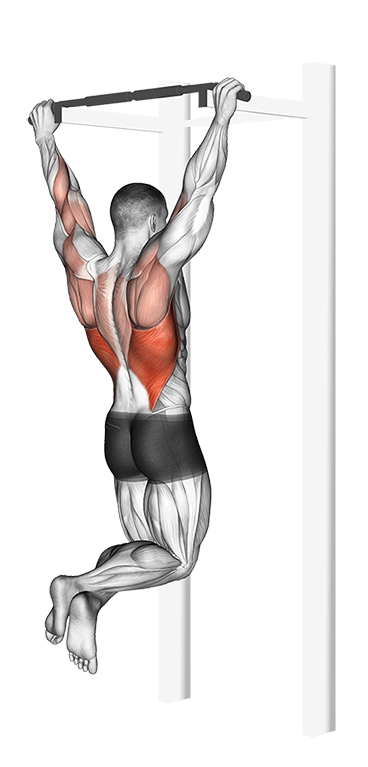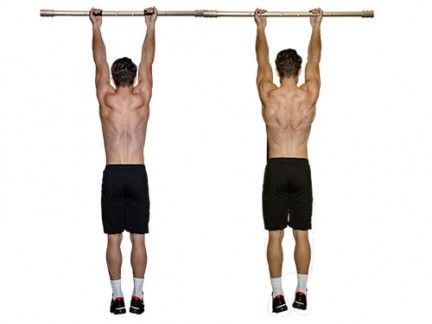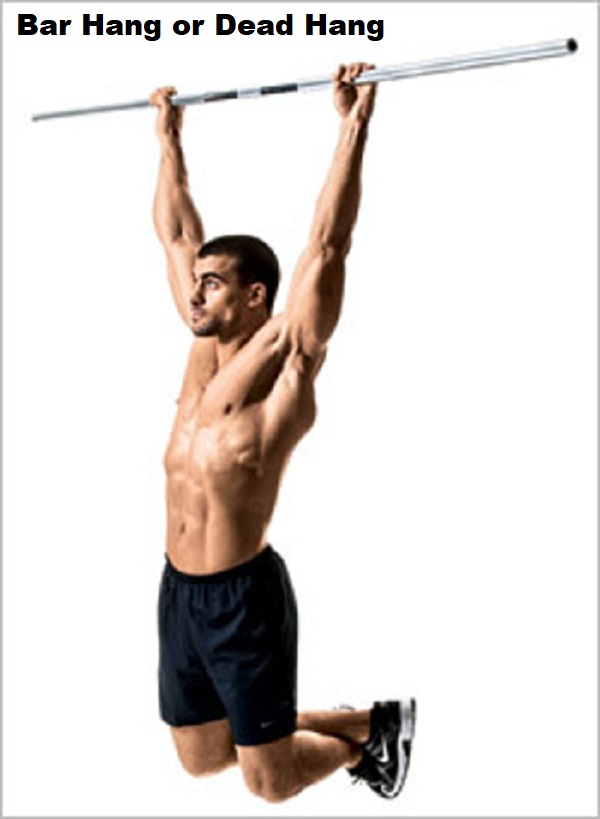Because It’s The Most Underrated Exercise For Lower Back Pain…
TIP: If you struggle to hang on a chin-up bar this isn’t for you…
Have you given your body a nice stretch?
Especially around your arms and shoulders…
It reduces muscle soreness and releases accumulated tension.
Hanging movements support reflex stabilization.
This is crucial to healthy and injury-free shoulders.
People rarely train the overhead arm position…
So bar hang exercise is unique for both strength and range of motion.
This bar hang exercise can help to target abdominal muscles as well.
Great for stability, strength, improving compound pulling exercises.
The bar hang or dead hang strengthens these muscle groups:
- upper and lower back
- shoulders
- arms
- abdominal, core
- forearms
- hand and wrist flexors
Why use a chin-up bar to stretch your spine?
Bar hang-ups are great for spinal decompression…
How does spinal decompression work?
Spinal decompression works to reduce pressure on joints and nerves.
This helps by increasing space between vertebrae and nerves.
By pulling in opposite direction of gravity…
The stretch increases blood flow between space and decreases pressure.
And this is how you can help alleviate your back pain and/or symptoms.
Bar hang-ups…
Basically all you need is a pull-up or chin-up bar.
Hanging from a bar to decompress spine and alleviate pain…
1) Only use a bar which is safe and sturdy
2) Reach up and grab bar, allow your body to hang
3) Get comfortable and slowly increase load, keep your arms straight.
And squeeze shoulder blades together for stability.
You’ll feel your body weight by “hanging” and relaxing your muscles.
4) Hold for 10-30 seconds depending on your comfort levels
5) Let go of the bar and place your feet firmly on the ground
6) Take a one minute break and repeat 2-5 times
7) This exercise can be repeated 2-3 times per day
What muscles do bar hang work?
A straight-arm hang works your hand and wrist flexors.

And (brachioradialis, extensor carpi radialis muscles)
Your forearms and deltoid muscles in shoulders.
And specifically targets muscles to improve grip.
Grip is essential in many exercises, including pull-ups.
You can vary your grip to target other muscle groups…
Different hand variations; wide, narrow, overhand, underhand grip.
Also give one-handed hangs a shot to help stretch your shoulders.
What if you are very comfortable hanging with both hands?
Try one hand at one time to increase your grip strength.
Use this bar hanging stretch as a segue before doing pull-ups.
This bodyweight exercise works entire back, shoulders, arms and abs.
Including decompressing lower back to relieve pain.
Let’s face it, you’re working and doing day-to-day activities…
The vertebrae of your spine gets loaded, twisted and compressed.
This often results in micro-tear of muscles.
And it can result in inflammation, irritating back pain and stiffness.
While inversion machine or gravity boots can be expensive.
Both options offer some relief for stretching your spine.
For most people, it might not the best solution.
The reason why is the lack of flexibility.
You also need strong abdominals to get into inverted position.
Dead hang is another option…
Start by positioning yourself underneath center of a pull-up bar.
Reach up, grip bar with both hands, palms facing away from you.

Use a pull-up or chin-up bar at the gym or home.
The basics is all you need as this does the trick.
Stretching the vertebrae using a chin-up bar…
Sounds pretty simple, right?
Actually it is a proven form of spinal decompression.
And the explaination isn’t complicated either.
Look, it doesn’t get any simplier than this.
I mean hanging from a bar…
Stretching for a few minutes at a time isn’t rocket science!
Want a quick effective stretch before your workout routine?
Especially if your training includes any weight loaded exercises.
For example:
Back intensive exercises like squat, t-bar row, bent-over row, deadlift.
Consult a doctor if new to exercise or have been inactive for a long time.
And if any existing injury or back pain make sure to get medical advice.
Step 1: Grasp the chin-up bar with both hands.
Simply use either an overhand or underhand grip.
Place your hands slightly wider than shoulder-width apart.
If you’re unable to do pull-ups, use a sturdy stool to reach bar.
Step 2: Bend knees so feet can stabilize and don’t touch floor.
Cross your feet at ankles if it helps.
(May assist you in holding your legs together).
Allow your body to totally relax and hang…
(Breathe slowly, controlled, steadily and deeply).
The key is feel your body and relax completely…
Until you feel tension draining from head to toe.
Step 3: Hang for as long as you comfortably can…
Or until you feel a loosening of tension in your spine.
Back exercise stretch for vertebrae from thoracic to lumbar…
And loosens the shoulder joint and muscles as well.
If done properly, you should feel almost instant relief.
You’ll feel a release of tension from upper and lower back.
As well as shoulders at the end of stretch.
Give yourself time with regular practice to reap rewards…
That way you’ll be able to hang longer on the bar each time.
Set a goal of 10 seconds on day one.
And over time, gradually increase stretching/hanging time to 2-3 minutes.
Aim for 2-3 minutes as this is an approximate guide for 1 month progress.
Bar hang up using overhead rings…
Overhead rings aren’t as stable as a bar.
So this means an additional challenge.
Use a step or bench to easily reach the overhead rings.
Grip one ring with each hand as you step off the bench to hang.
You can lift your legs so your knees are bent…
Depending on how high the rings are.
Keep your arms straight as you hang.
Hang on to rings for 10 to 30 seconds.
Work up to 3 sets…
P.S. This type of back exercise works for spinal decompression.
And helps give relief of shoulders and lower back pain.
However, it is very important to note this back exercise is just a guide.
And you should consult a healthcare professional before commencing.
Exercise can increase pain level, please make sure this is suitable for you.

